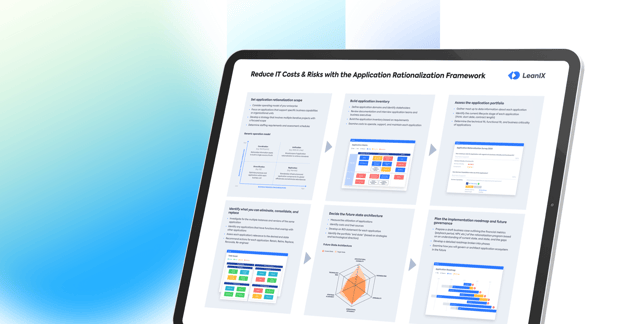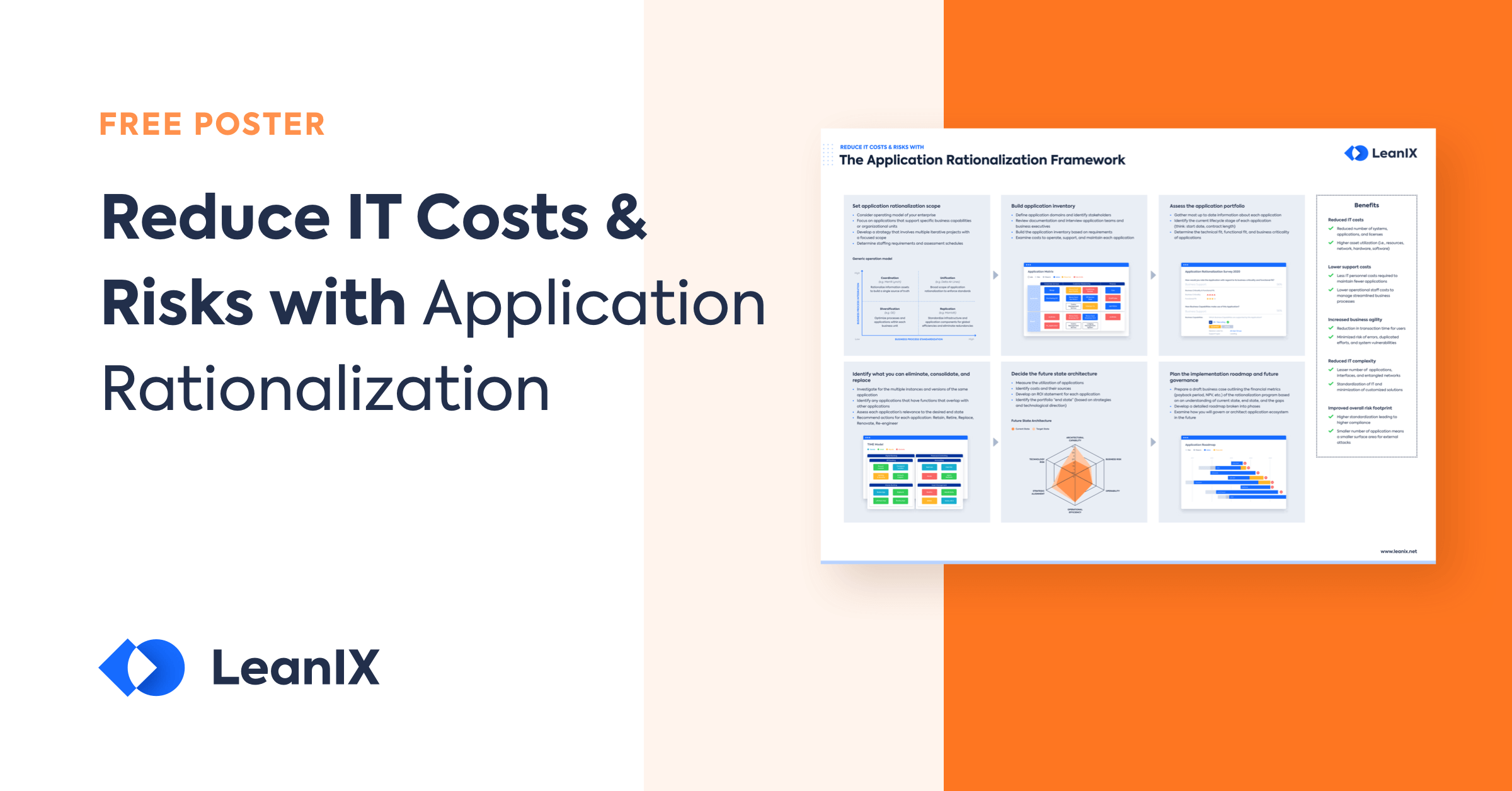
Managing a modern, enterprise-level IT infrastructure is no small undertaking. LeanIX has found that most large companies now operate 650+ applications, and the largest 10% have more than 3400 — and that’s just software.
Intentional IT rationalization — strategic decision making about how your organization acquires, uses, and phases out IT assets — is a necessity for modern businesses. Without it, companies end up carrying excessive technical debt, operating inefficient processes, and having less control over how new tools are vetted and procured.
On the flip side, Gartner reports that organizations that actively manage and reduce technical debt achieve 50% faster service delivery times to the business.
In this guide, we’re going to walk step by step through the basics of IT rationalization. We’ll cover:
- Why IT rationalization is important
- What you need to do it effectively
- 7 proven steps for successful execution
- How an EAM solution can help
Let’s get started.
Quick Takeaways
- According to Gartner, companies that actively manage and reduce their technical debt achieve 50% faster service delivery times to the business.
- LeanIX has found that 70% of organizations do not have current documentation of their IT portfolios (let alone the ability to rationalize them).
- A diverse IT team and an EAM solution are essential for successful IT rationalization.
- IT rationalization should be implemented as an ongoing business practice rather than a one-time initiative.
Why is IT Rationalization Important?
Rationalizing your IT estate is important for one simple reason: Business – and the technology that is core to business today – moves fast.
New norms around remote work and digital customer experience have pushed organizations to the cloud and focused them on other IT modernization initiatives at an unprecedented pace. And the way we do business continues to evolve. At the same time, the rate at which IT becomes obsolete gets faster every year.
Ongoing, effective IT rationalization is the only way to stay ahead of it all.
It’s what empowers organizations to maintain cost- and value-optimized IT infrastructures that drive greater efficiency, stronger collaboration, and smarter strategic decision making.
Despite this, however, LeanIX has found up to 70% of organizations don’t even have formal documentation of their IT portfolios. They’re likely wasting significant time and money on tech that isn’t being used or may even be degrading business performance.
Companies that execute smart IT rationalization strategies and maintain this focus over time can quickly differentiate themselves from their laggard counterparts. They’ll be better positioned for agility amidst market uncertainty, maximize the ROI of their IT infrastructures, and deliver better experiences to employees, customers, and other stakeholders.
What You Need to Do It
Before you can actually implement an IT rationalization plan, there are two things you need to have in place: The right team and a modern enterprise architecture management (EAM) solution.
Your team should include IT employees with broad technical knowledge and a deep understanding of you business. Above all, this team will need to appreciate what makes specific applications and other IT assets important from the perspective of business users.
Your EAM solution serves as a single source of data truth and a central place for collaboration. It also provides the tools and capabilities you need to actually support your rationalization efforts.
Without these two critical pieces of the puzzle, you’ll be at risk of executing a piecemeal and manual strategy that won’t achieve your desired goals. Investing in both the right team and right solution will drive better results and deliver higher long-term ROI on your efforts.
How to Execute IT Rationalization
Set goals
Your company will experience numerous benefits from a successful IT rationalization, but it’s important to identify the specific priorities and drivers behind your efforts.
For example: Are you trying to reduce technical debt by 20%? Achieve greater collaboration between business units? Reduce TCO by 15%? Free up resources for investment in product innovation?
Before you start your IT rationalization, spend time with your IT leadership and execution team to identify and define your objectives, map them to business value, and identify metrics you’ll use to measure success.
Inventory your current IT portfolio
Next, take stock of your current state IT landscape. Inventory every application, host environment, and other IT component currently in place. Ideally, you should create a visual representation of your current state. This will allow you to view your actual assets as well as understand how they interact to support your business.
Assess business value and technical fit
Every asset in your inventory needs to be evaluated for value and fit. The best way to do this is through a survey sent to application owners to collect data on things like:
- Purpose - Why was this application/asset added? What business objective does it currently serve?
- Usage - How often is it used and by whom?
- Effectiveness - Does the application/asset still serve its intended purpose?
- Importance - How mission critical is the application/asset?
A good EAM solution can help you streamline this process by automating the survey process, sending reminders, and aggregating data. It’s important during this step to look for redundancies across your infrastructure and determine where two or more different assets are implemented for the same purpose.
Make decisions
Your team will now need to make decisions about which applications and assets to keep, update, or eliminate from your infrastructure. This usually requires further communication with business users to clarify requirements and gather further details that will inform final decisions.
The goal of your rationalization team is to make informed, objective decisions based on what’s best for the business and what will drive achievement of strategic goals. What should be avoided is making decisions solely based on the technical preferences of individuals or specific teams (though the needs and preferences of your end users can't and shouldn't be discounted!).
Communicate effectively with stakeholders
IT rationalization creates change. And change generates opinions and feedback from people across the organization. The best strategy is to welcome this feedback. You have to listen to your users, even though your decisions may not make everybody happy.
What might sound like a complaint may in fact be an important insight revealing an unanticipated impact of your efforts. Listening for such insights will help you with the change management that successful IT rationalization demands.
At the same time, it's important to remember that IT rationalization is not an academic exercise. It's a vital part of continuous transformation and operational improvement. Don't hesitate to remind people of the benefits and business value your optimized infrastructure will bring. Customize this message as much as possible for individual stakeholders, departments, and teams.
Track progress and results
As you implement planned changes, track your progress against the KPIs and metrics you identified in the beginning. Report on your progress publicly, celebrating successes and being transparent about setbacks and challenges encountered along the way.
Develop a plan for ongoing IT rationalization
Today’s business environment requires that IT rationalization be more than a one-time initiative — it must be an ongoing practice.
As part of your current IT rationalization plan, build a permanent strategy that includes effective and continuous application portfolio management and legacy system modernization. You should also develop detailed processes for adding new assets to your IT infrastructure. Focus on establishing a culture around optimizing IT at your company so that every user can also be a contributor.
How LeanIX Can Help
LeanIX’s comprehensive EAM solution helps clients build technology landscapes that power outstanding customer experience and drive business transformation.
Learn more about our EAM solution and schedule your demo today!





